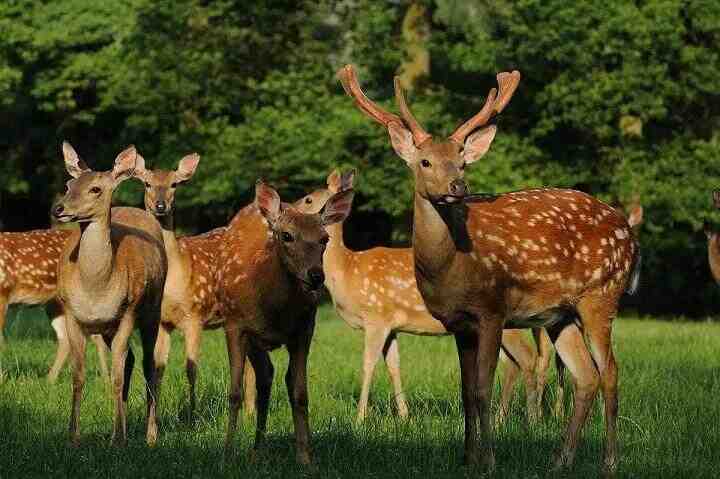Cervus nippon
IUCN
LCBasic Information
Scientific classification
- name:Cervus nippon
- Scientific Name:Cervus nippon,Sika Deer,Flower deer, deer
- Outline:Ungulata
- Family:Artiodactyla S.Rumina Cervidae S.Cervidae G.Cervidae
Vital signs
- length:125-145cm
- Weight:70-100kg
- lifetime:About 20 years
Feature
It is a species native to eastern Asia.
Distribution and Habitat
The sika deer is a species native to eastern Asia, mainly distributed in eastern Russia, Japan and China. In China, it is mainly concentrated in a few limited areas such as Heilongjiang, Jilin, Liaoning, central Inner Mongolia, southern Anhui, northern Jiangxi, western Zhejiang, Sichuan, and Guangxi. There is also an endemic subspecies in Taiwan [3]. Sika deer have been introduced to Armenia, Austria, Azerbaijan, the Czech Republic, Denmark, Finland, France, Germany, Ireland, Lithuania, Madagascar, New Zealand, the Philippines, Poland, Ukraine, the United Kingdom and the United States. However, in South Korea, sika deer have become extinct, and populations in North Korea and Vietnam are also at risk of extinction.
Sika deer live in forest edges and mountain grassland areas. In the United Kingdom, where they were introduced, the habitat of sika deer is very wide, including broad-leaved forests, swamps, salt marshes and islands.
Appearance
The sika deer is 125 to 145 cm long, with a tail length of 12 to 13 cm, a shoulder height of 70 to 95 cm, and a weight of 70 to 100 kg. The head is slightly round, the face is long, the nose is exposed, the eyes are large and round, the infraorbital gland is slit-shaped, the tear trough is obvious, the ears are long and upright, the neck is long, the limbs are slender, the main hoof is narrow and pointed, the side hoof is small, and the tail is short.
The fur color changes with the seasons. In summer, the body fur is brown or chestnut red, without fluff, and there are many orderly arranged white spots on both sides of the back and the lower edge of the body, which looks like plum blossoms, hence the name. In winter, the body fur is smoky brown, and the white spots are not obvious, similar to the color of dead thatch. The neck and the back of the ears are gray-brown, and a black dorsal midline runs from the tip of the ear to the base of the tail. The abdomen is white, and there are w
Details
Sika deer, also known as sika deer in English, is a small to medium-sized deer with 16 subspecies.

Sika deer are alert, agile, have well-developed hearing and sense of smell, but weak vision, and are timid and easily startled. Because of their slender limbs and narrow and pointed hooves, they can run fast and jump very well, especially climbing steep slopes. They can jump continuously with large spans and are agile and light. Sika deer are not very gregarious. Adult males often live alone. They migrate short distances in summer and winter and have a certain sense of territory, especially during the breeding season. When a dispute occurs, antlers and hooves are often used as the main weapons.
Sika deer move at dawn and dusk, and their living areas change with the seasons. In spring, they live mostly on semi-shaded slopes, eating young branches and leaves of trees and shrubs such as oak, chestnut, Lespedeza, wild hawthorn, and elm, as well as newly sprouted herbs. In summer and autumn, they migrate to the forest edge of the shady slopes, mainly feeding on vines and herbs, such as kudzu, Polygonum multiflorum, Codonopsis pilosula, strawberries, etc. In winter, they prefer to live on the warm sunny slopes, eating mature fruits, seeds and various mosses and lichens. Occasionally, they go to the foot of the mountain to eat crops such as rapeseed and wheat, and often go to saline-alkali land to lick salt and alkali. During the day, they choose to live on sunny slopes, where the grass is dense and the body color is similar. At night, they live in the middle or upper middle part of the slope. The slope direction is uncertain, but they still live on sunny slopes. The grass in the habitat is relatively low and sparse.
Adult sika deer reproduce once a year. From September to October every year, male sika deer will mate with multiple female deer. The gestation period of female deer is about 30 weeks. They reproduce from May to June of the following year. Each litter has one fawn, and it is rare to have two fawns. The weight of a fawn is about 4.5 to 7 kg at birth. It grows rapidly, is weaned in late summer, becomes independent at 10 to 12 months, and reaches sexual maturity at 16 to 18 months.
There are a large number of sika deer in Japan, and the number of individuals is still increasing. At the same time, the number of deer distributed in Russia and Taiwan has remained stable, making the sika deer listed as low risk by the World Conservation Union (IUCN). However, in North Korea and Vietnam, the population is in danger of extinction. In China, due to excessive capture and hunting, the number of wild deer is extremely small, and the distribution range is decentralized, so it is listed as an endangered animal. Artificial breeding of sika deer has appeared in Liaoning, Jilin and other places in Northeast China, with the number of breeding reaching hundreds of thousands.
It is a first-class protected animal in China and is listed in the "Red Book of Endangered Animals in China" - endangered.
Listed in China's "List of National Key Protected Terrestrial Wildlife under Artificial Breeding (First Batch)".
Listed in the 2015 "Red List of Endangered Species" of the World Conservation Union (IUCN) ver 3.1 - Low Risk (LC).
Listed in the first level of the "List of National Key Protected Wildlife in China".
Protect wildlife and eliminate game.
Maintaining ecological balance is everyone's responsibility!








